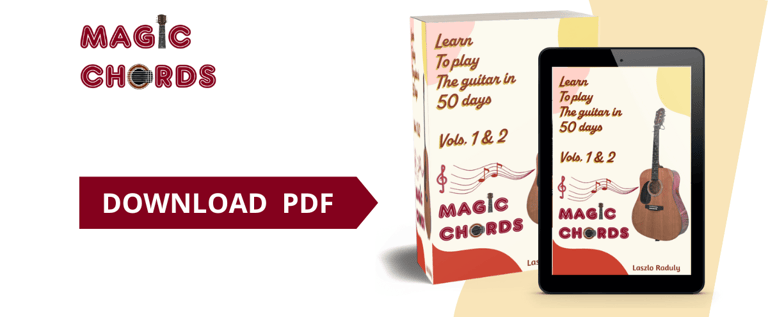
Guitar for beginners: How to switch chords quickly
Learn how to switch chords quickly with tips, exercises, and practice routines designed for beginners. Improve your transitions and play your favorite songs.
magicchords.com
7/16/2025


One of the biggest challenges for beginner guitar players is mastering smooth and fast chord changes. Struggling with this can make songs sound choppy and frustrating to play. If you’ve ever wondered how to switch chords quickly without breaking the rhythm, you’re not alone. This skill is essential for developing fluidity, building confidence, and enjoying your guitar journey from the very beginning.
🎸 POST CONTENT:
1. Why Learning to Switch Chords Quickly Matters
2. Common Challenges When Switching Chords
3. How to Switch Chords Quickly: Step-by-Step Tips
4. Finger Exercises That Improve Speed and Accuracy
5. Practice Routines for Faster Chord Switching
6. Tools and Apps That Help You Improve
7. Stay Patient: Progress Comes with Consistency
Learning how to switch chords quickly involves more than just speed. It’s about building muscle memory, improving finger accuracy, and knowing simple tricks that reduce unnecessary hand movement. With consistent practice and the right techniques, even total beginners can dramatically improve their chord transitions in just a few weeks.


In this guide, we’ll explore proven tips to help you switch between chords with ease. You’ll learn how to position your fingers efficiently, use anchor fingers, and follow simple exercises that make your practice more effective. Whether you're learning on an acoustic or electric guitar, mastering this skill will open the door to playing full songs and progressing much faster.
One of the most common obstacles beginners face is switching chords quickly and smoothly. It's the difference between choppy playing and fluid, rhythmic strumming. Mastering this essential skill opens the door to playing full songs with confidence and makes practice sessions more enjoyable. So grab your guitar, tune it up, and let’s dive into how to switch chords quickly and confidently—because smoother changes mean more fun and better music.


Why Learning to Switch Chords Quickly Matters
Efficient chord switching is at the heart of every great rhythm guitarist. Without it, even simple songs become difficult to play. Smooth transitions keep the rhythm intact, maintain timing, and ensure that your playing sounds clean and professional. For beginners, this skill boosts confidence and allows for a more immersive experience with music. It turns practice from a struggle into a creative outlet. Additionally, quick chord switching helps build muscle memory, finger dexterity, and a better sense of timing, all of which are foundational skills for advancing as a guitarist. Playing along with others, recording music, or performing live becomes more accessible when your hands can find their place without hesitation. It’s not just about speed; it’s about playing fluently and musically.


Have a nice peace of advice from us: The Ultimate Guitar Setup Guide is your go-to resource for transforming your instrument into a smooth-playing, great-sounding guitar. A proper setup ensures better tone, easier playability, and improved tuning stability. Whether you're a beginner or experienced player, learning how to adjust string height, neck relief, and intonation can dramatically enhance your playing comfort and overall musical experience.
Common Challenges When Switching Chords
Most beginners experience the same set of difficulties when learning to switch chords. One common problem is finger placement. If your fingers aren't trained to land in the correct position, you’ll constantly need to adjust them, which slows you down. Another issue is finger strength and flexibility, especially in the early stages when your hands aren’t used to holding chord shapes. Strumming patterns can also complicate matters—trying to maintain a steady rhythm while switching chords is a multitasking skill that takes time to develop.


A lack of muscle memory is another major hurdle. Until your fingers learn the movements instinctively, you’ll need to look down at your hands, which interrupts your flow and distracts you from the rhythm. Frustration can also become a mental block. Many beginners give up or stop enjoying the process when they feel like they’re not improving. Understanding that these struggles are normal and can be overcome with patience is the first step toward progress.
How to Switch Chords Quickly: Step-by-Step Tips
The key to improving your chord switching lies in small, consistent efforts and correct technique. Start by learning one transition at a time, such as going from G to C. Practice slowly, focusing on finger movement and placement. Visualize the chord shape before you move your fingers. This mental preparation can help your hands respond more quickly. Use anchor fingers when possible. An anchor finger is one that stays in place or shifts only slightly when moving between chords. For example, when switching from C to A minor, the index and middle fingers stay in nearly the same position. Recognizing these anchors minimizes unnecessary movement.


Keep your fingers close to the fretboard. Avoid lifting them too far away when switching chords. The closer they are, the faster they can land on the next shape. Practice "ghosting" the chord changes—move your fingers to the next chord shape without strumming. This allows you to focus entirely on the motion without worrying about sound quality at first. Repetition is essential. Set aside a few minutes during each practice session to drill specific chord changes. It may feel repetitive, but it builds the muscle memory that leads to quick, smooth transitions.
Finger Exercises That Improve Speed and Accuracy
Finger strength and independence are crucial for switching chords quickly. Simple finger exercises can make a big difference. One effective drill is the spider walk: place your fingers on frets 1 to 4 across four strings and walk them up and down the fretboard, one finger at a time. This develops finger control and coordination.
Another helpful exercise is the "finger lift." Form a chord, then lift all your fingers off slightly and return them to the same chord shape. Do this repeatedly until your fingers naturally fall into place without needing to readjust. You can also practice placing fingers on the fretboard one at a time in the correct order, then eventually try placing them all at once.


Stretching and warm-up exercises also prevent stiffness and fatigue. Stretch your fingers before and after playing, and shake out tension in your hands and wrists. Use light hand grips or stress balls to build overall finger strength during breaks. Finger dexterity games and finger tapping exercises also build agility, making chord changes faster and more accurate.
Practice Routines for Faster Chord Switching
To see real improvement, establish a structured practice routine that focuses on chord transitions. Begin with a five-minute warm-up using finger exercises. Then, dedicate 10–15 minutes to targeted chord changes. Choose 2–3 chord pairs and practice switching back and forth slowly at first, gradually increasing speed as you improve. Use a metronome to stay on beat. Start slow—around 60 beats per minute—and increase the tempo as you grow more confident. Time-based drills like “one-minute changes” are also useful. See how many times you can switch between two chords in one minute without sacrificing clarity.


Integrate chord switching into songs. Choose simple three-chord songs that use the transitions you’re practicing. Playing real music keeps practice engaging and shows you your progress in a musical context. End your routine with a cool-down: play something you enjoy or revisit a favorite song. This keeps your motivation high and helps reinforce the progress you’ve made. Consistency is more important than duration. Practicing 15–20 minutes daily is more effective than a single long session once a week.
Tools and Apps That Help You Improve
Technology offers several tools that can accelerate your chord switching progress. Guitar apps like Yousician, Justin Guitar, or Fender Play provide step-by-step lessons and interactive feedback on your playing. These apps often include chord transition drills and progress tracking. Chord chart apps display finger positions and allow you to practice along with backing tracks. Use slow-down apps like Anytune or Amazing Slow Downer to reduce the tempo of songs while maintaining pitch, so you can practice chord changes at a manageable speed.
A metronome app helps with timing and consistency, and video tutorials on platforms like YouTube offer visual guidance and encouragement. Recording your practice sessions—even with a phone—lets you listen back and hear your progress. This reinforces learning and helps identify areas for improvement. E-books like Magic Chords: Learn to play the guitar in 50 days! can transform your guitar journey. With guided practice and smart features, digital contents like these help beginners learn to switch chords quickly and even master playing the guitar in just a few months.
Guitar tuning apps also ensure your instrument sounds right, preventing confusion during practice. If you're unsure whether a chord sounds correct, having a well-tuned guitar eliminates one variable.
Stay Patient: Progress Comes with Consistency
It’s easy to become discouraged when results don’t come as quickly as you’d like. But learning how to switch chords quickly takes time, repetition, and a positive mindset. Every guitarist has faced this challenge and worked through it. Remind yourself that daily practice leads to gradual improvement, even if you don’t notice it immediately. Set small goals, such as mastering one chord change per week. Celebrate these wins, no matter how minor they seem. Keep a practice journal to track what you’ve worked on and how you felt about your sessions. This reflection helps you stay motivated and reinforces a growth mindset.


Avoid comparing your progress to others. Everyone learns at their own pace. Focus on the joy of making music and remember why you picked up the guitar in the first place. If you ever feel stuck, try changing your routine slightly, seek feedback from a teacher or online community, or revisit simpler exercises. Progress may be slow at times, but with consistent practice and the right approach, you will get faster and better at switching chords.
In the end, mastering chord transitions not only improves your playing but also builds the foundation for becoming a confident, expressive guitarist. So keep practicing, stay positive, and enjoy the journey.






